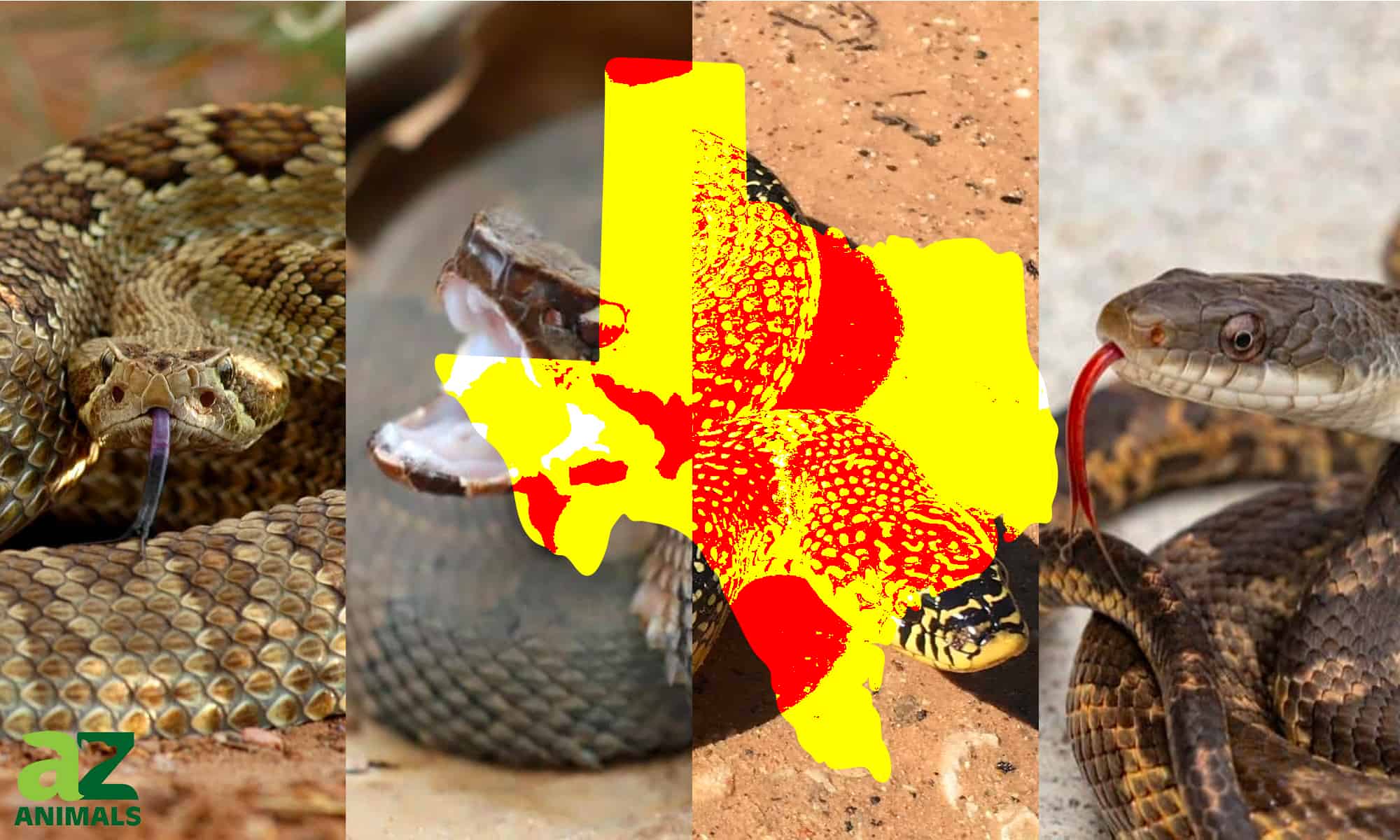Key Points:
- Texas is home to 105 species of snakes.
- The four venomous snake species in the state include coral snakes, copperheads, cottonmouths, and rattlesnakes.
- Texas indigo snakes, Texas rat snakes, and Texas kingsnakes are considered the largest snakes to live in the state.
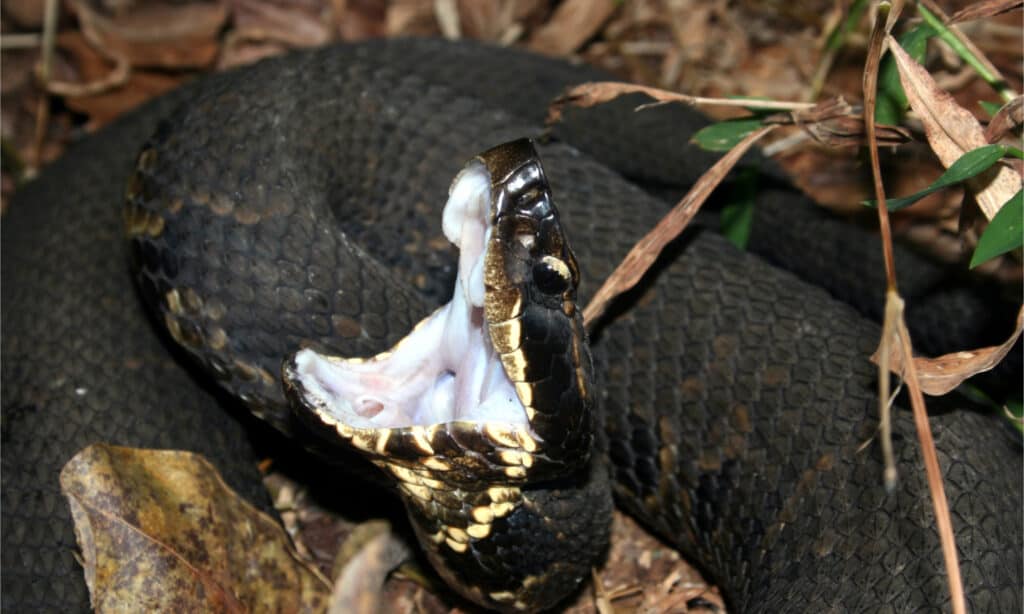
There are more than 105 species of snake in Texas with only four, including the cottonmouth, being venomous.
©Psychotic Nature/Shutterstock.com
There are lots of snakes across the state of Texas, some of them large and some of them small! While many people may think that big equals dangerous, this isn’t always the case. In fact, some of the largest snakes in the state are the most harmless, while some of the smallest can be extremely venomous! Today, we are going to take a look at some of the most dangerous snakes in Texas, plus learn which snakes in Texas get the biggest. Let’s discover Texas’ three largest and four most dangerous snakes this summer.
Comparing Large and Dangerous snakes
There are more than 105 species of snake in Texas alone! Thankfully, many of these serpents are totally harmless. Of the 105 snakes, only four primary species (15 including subspecies) are dangerous to humans. The rest aren’t dangerous to humans (besides maybe a little nip if you get too close).
As the state is known for the motto “everything’s bigger in Texas,” it’s also only fitting that the state is home to the largest snakes in the United States. Additionally, there are some other snakes that can get pretty large! Thankfully, many of the largest snakes aren’t venomous, and many of them actually live off of other venomous snakes as their primary food source.
Let’s take a look at the most dangerous and largest snakes in Texas.
Dangerous Snakes in Texas
There are four species of snake in Texas that are truly dangerous. Each of these snakes has a potent venom that can harm or even kill a human. Each species can be further broken into its subspecies which are usually separated by location and distribution. Let’s learn about these dangerous snakes.
Coral Snakes
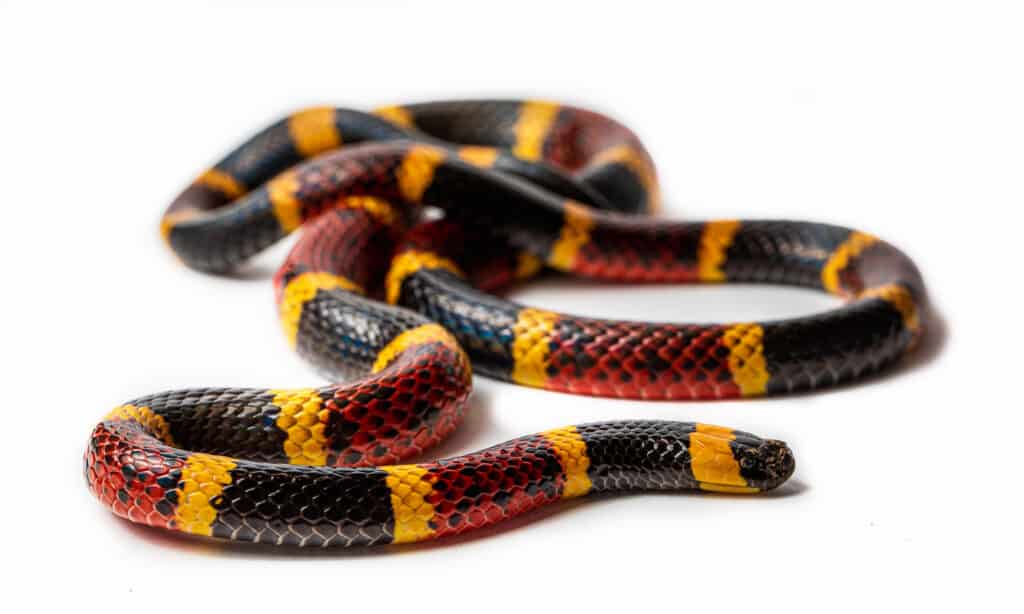
The Texas coral snake is regarded as the most venomous snake in the state.
©Scott Delony/Shutterstock.com
Texas coral snakes are somewhat new as their own species. They used to be classified as subspecies of the eastern coral snake, but scientists decided that they were different enough to be separated into their own category. Coral snakes are beautiful and vibrant snakes that live all across the southern United States, plus Central and South America. All New World coral snakes belong to either the Micruroides or Micrurus genus, and all of them are venomous. They are closely related to the Indian cobra.
Identification: Texas coral snakes have a distinct colored band pattern. The pattern goes as follows: thick black band, thin yellow band, thick red band, thin yellow band. There are hundreds of coral snake mimics worldwide, all hoping to deter predators by looking just like the venomous coral snake. For coral snakes in North America, the best way to tell coral snakes from their mimics is that true coral snakes never have red and black bands touching one another in sequence. Beware, however, as there are occasional black spots across the red bands in some individuals. Still, the banding pattern should remain true.
List of coral snakes in Texas:
- Micrurus tener fitzingeri – Guanajuato coral snake
- Micrurus tener maculatus – Tampico coral snake
- Micrurus tener microgalbineus – Spotted coral snake
- Micrurus tener tamaulipensis – Tamaulipas coral snake
- Micrurus tener tener – Texas coral snake.
Copperheads
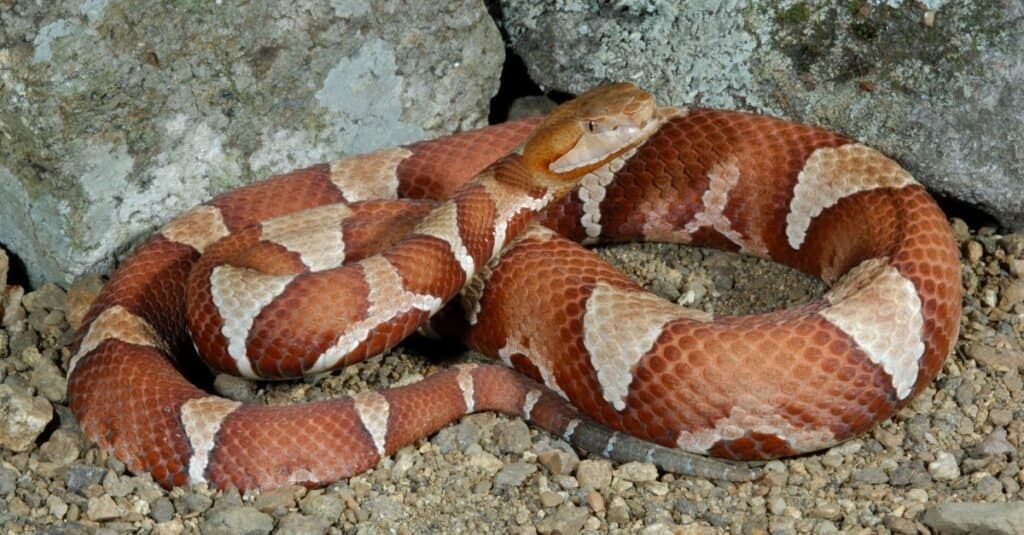
There are three types of copperhead snakes that can be found in Texas.
©Breck P. Kent/Shutterstock.com
Copperheads are some of the most widely distributed venomous snakes in North America. There are three subspecies, each with its own distinct appearance. Copperheads belong to the pit viper family, along with rattlesnakes and cottonmouths. Although they are dangerous and quite venomous, their bites are usually non-lethal, and deaths are extremely rare. Still, expect to be in excruciating pain for a while if you get tagged by one of these snakes!
Identification: Copperheads are a light tan or copper color with banding down their backs. The southern copperhead has a darker and distinctive banding pattern that looks like hourglasses with the thinnest part near their spines. The other two subspecies of copperhead in Texas have broader bands and look extremely similar to one another. Aside from color, all pit vipers have clear pits near their nose between their eyes and mouth.
List of copperheads in Texas:
- Agkistrodon contortrix – Southern copperhead
- Agkistrodon contortrix laticinctus – Broadbanded copperhead
- Agkistrodon contortrix pictigaster – Trans-Pecos copperhead.
Cottonmouths
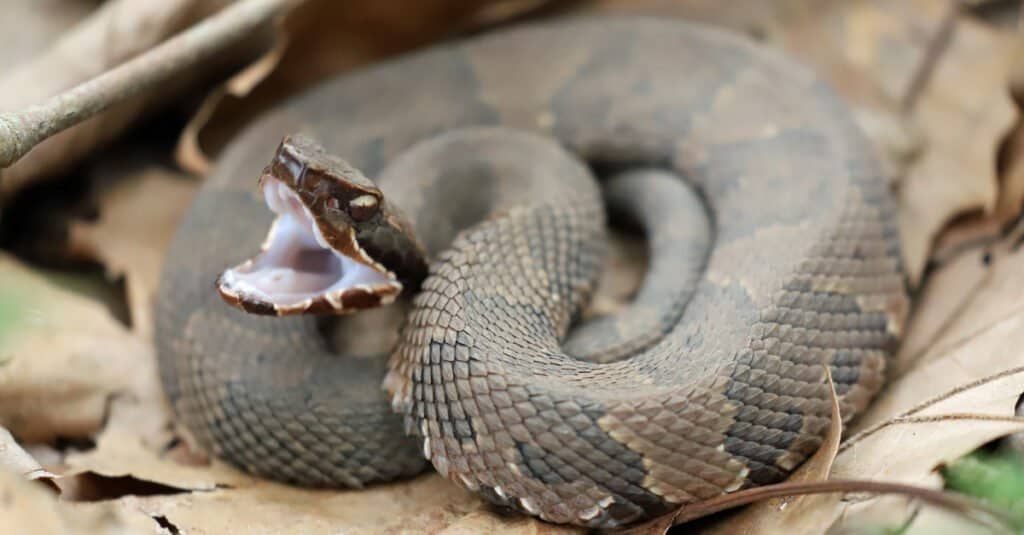
Cottonmouths get their name from their white mouths that they flash as a defensive measure.
©KF2017/Shutterstock.com
Cottonmouths are aquatic snakes that live all over the southeastern United States. They go by a few names, including water moccasins, black moccasins, gapers, mangrove rattlers, snap jaws, stub-tail snakes, swamp lions, trap jaws, water mambas, and water pilots.
Identification: Cottonmouths get their name from their defensive posture which is easily identifiable. When threatened, they open their bright white mouths and orient their bodies in a coiled s-shape. They are thick snakes that come in shades of gray and occasionally brown. Cottonmouths generally lack patterns, but some individuals have washed-out splotches or bands on their sides and backs. Like all pit vipers, cottonmouths have pits on their snouts between their eyes and mouth that are clearly visible.
List of cottonmouths in Texas:
- Agkistrodon piscivorus – Western cottonmouth.
Rattlesnakes
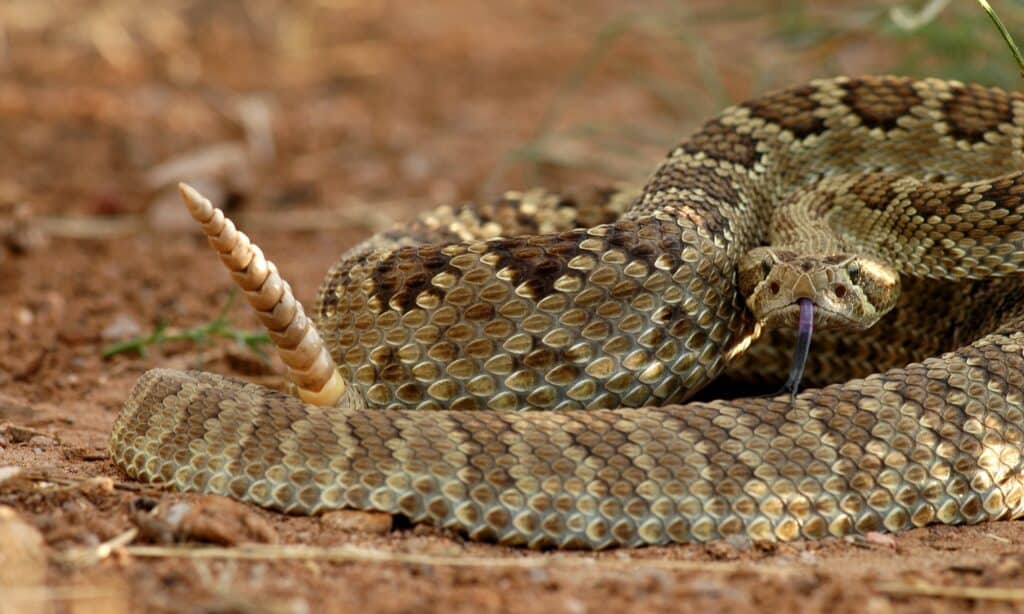
Rattlesnakes are probably the most commonly encountered venomous snakes in Texas.
©iStock.com/Shoemcfly
Rattlesnakes are some of the most famous snakes in the United States. They are extremely widespread, with more than 32 distinct species and 83 subspecies across the Americas. Seven distinct species live in Texas alone (more when counting their subspecies), all of which are extremely dangerous. The massasauga rattlesnake has the most potent venom, but it can only deliver a small amount per bite. When it comes to the deadliest snake in Texas, the Mojave rattlesnake is likely the winner.
Identification: Since there are so many rattlesnake species in Texas, they can’t all be described together with only a few words. Still, some features can help you identify a snake as a rattlesnake, even if you can’t exactly tell what kind of rattler. Rattlesnakes are known for their tails which they rattle loudly when an intruder gets too close. Their sound is quite distinct and easily recognizable. Additionally, rattlesnakes are pit vipers and have small pits between their eyes and mouths on either side of their face.
List of rattlesnakes in Texas:
- Massasauga
- Desert massasauga
- Western Massasauga
- Mojave Rattlesnake
- Prairie Rattlesnake
- Rock Rattlesnake
- Banded rock rattlesnake
- Mottled rock rattlesnake
- Timber Rattlesnake
- Western Diamondback Rattlesnake
- Western Pygmy Rattlesnake.
Large Snakes in Texas
Although there are many venomous snakes in Texas, they aren’t always the largest ones! Here are a few snakes in Texas that can get pretty huge. Thankfully, none of these snakes are dangerous to humans.
Texas Indigo Snake
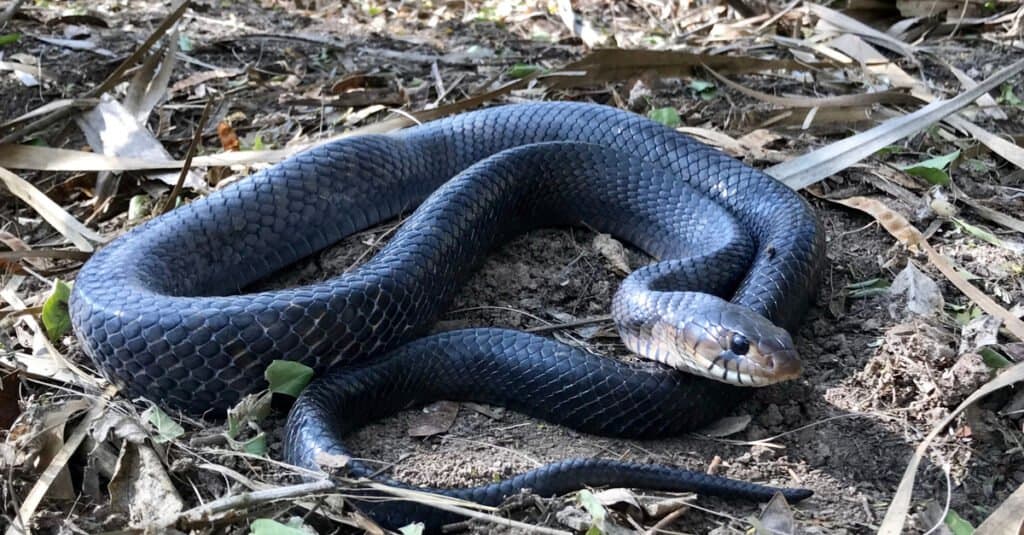
Texas indigo snakes are the largest snakes native to North America.
©Joe Farah/Shutterstock.com
The Texas indigo snake is the largest snake in the entire United States. The largest snake ever seen measured 8.5 feet long, setting the record in the States. Sadly, these snakes are endangered and at risk of extinction. They are extremely beautiful snakes characterized by their dark blue undertones that can appear inky black in some lighting.
Texas indigo snakes rule whatever environment they are in as they are resistant to other snakes’ venom and make a habit of preying on other snakes. Although these snakes aren’t dangerous to humans, rattlesnakes make a run when they see a Texas indigo snake on its way toward them!
Texas Rat Snake
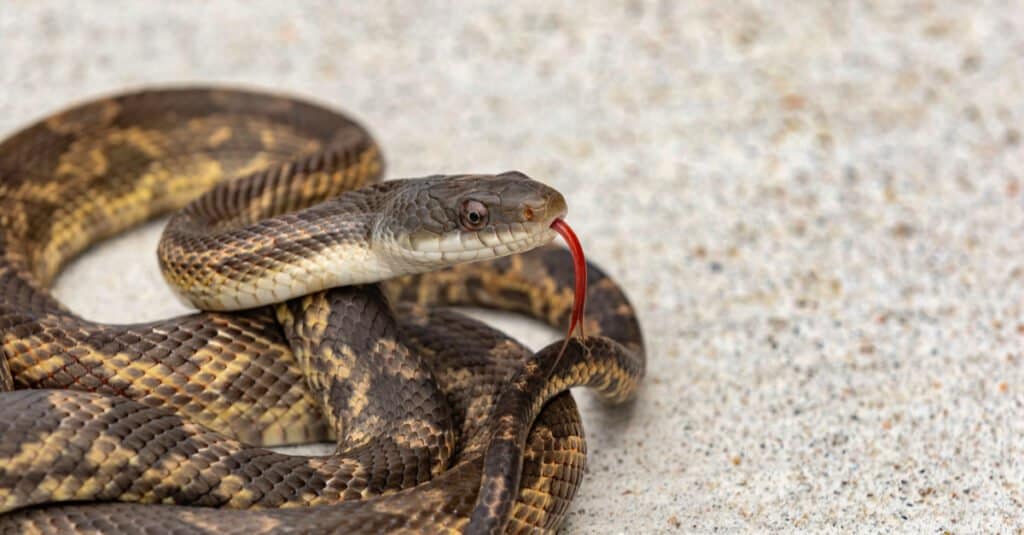
The skin of the Texas rat snake can come in multiple colors, including green, reddish-brown, or yellow.
©Silent Shoot/Shutterstock.com
Texas rat snakes are extremely common snakes that many people see in their yards, especially during the summer. These snakes aren’t venomous and can grow to 6 feet in length. Their favorite foods are small mammals, especially little rodents, giving them their name. Rat snakes live all over the United States, with the Texas rat snake being native to the state.
Most Texas rat snakes are brown and tan with spotted or splotchy patterns across their backs. Their bellies are white, and their eyes usually appear quite large in relation to their heads. Make sure you don’t kill these snakes, as they make sure rat and mouse populations don’t get out of hand!
Speckled Kingsnake
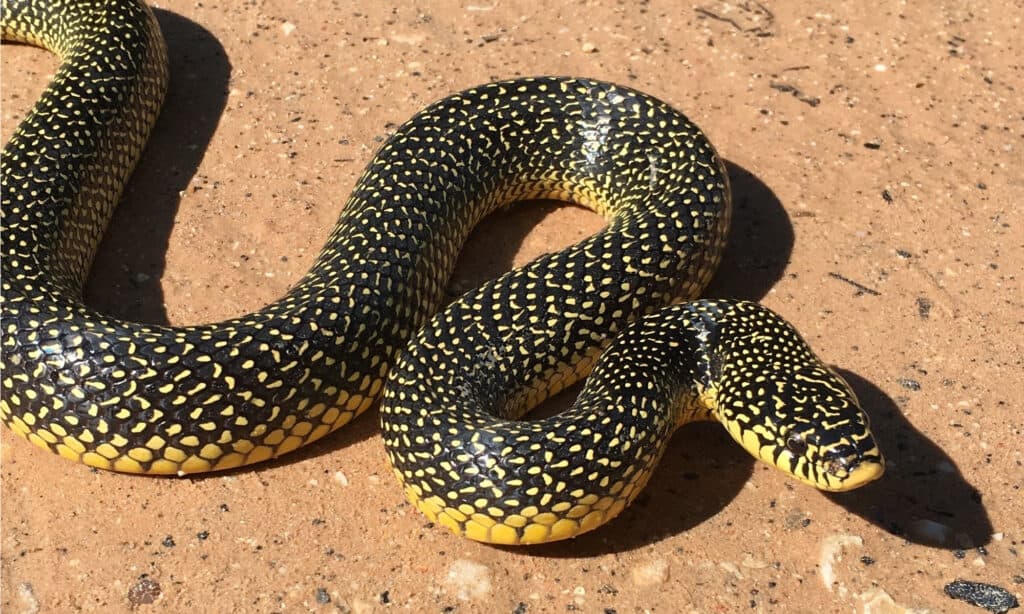
The
speckled kingsnake
is the largest kingsnake that can be found in Texas.
©Joe Farah/Shutterstock.com
Kingsnakes are a large group of snakes that belong to the genus Lampropeltis. There are six species of kingsnake in Texas, although all of them are nonvenomous. They get their name for their habit of eating other snakes, especially venomous ones. Kingsnakes are resistant to snake venom and are the strongest constrictors relative to the size of any snake in the world.
Speckled kingsnakes are the largest species of kingsnakes in Texas. These snakes generally grow to four feet, but some individuals have been recorded at a whopping 6 feet long.
What Do Snakes Eat?
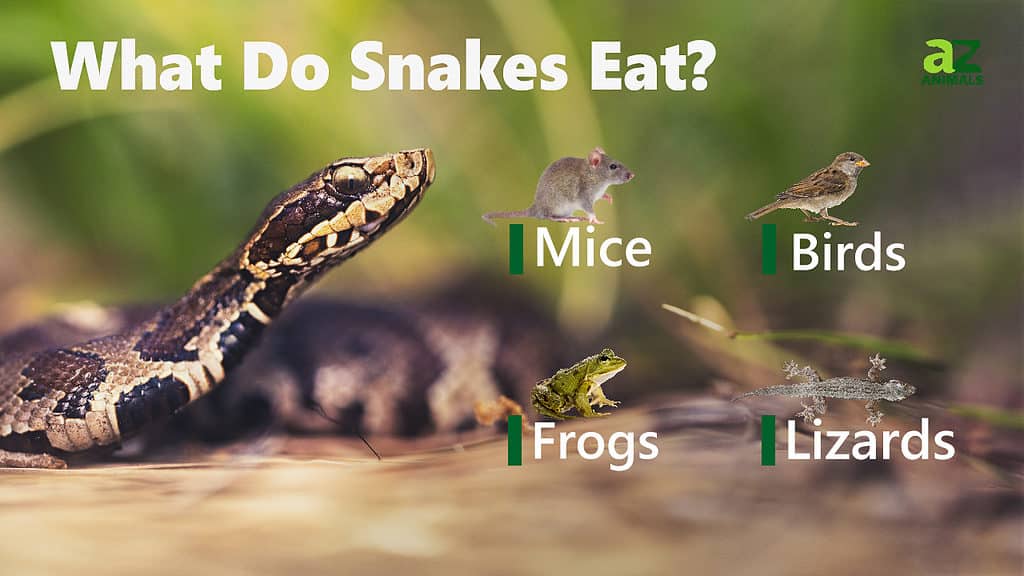
All species of snakes are carnivorous — there is no snake that even occasionally eats plants. A snake’s body just isn’t designed to derive nutrients from or digest plants. As a matter of fact, snakes don’t even chew their food but swallow it whole and mostly while the prey is alive. A snake’s digestive tract is made for the consumption of dense, high-calorie foods like rodents, frogs, lizards, and birds — all of which can be found just about anywhere including your backyard. It generally takes a few weeks for a snake to totally digest its food, meaning that it doesn’t eat too often.
Snake Bites in Texas
Venomous snake bites in Texas are relatively rare and deaths even more so, at around only 1 or 2 people dying each year from a venomous snake bite. Typically, copperheads, cottonmouths, or rattlesnakes are the attackers.
If you are unsure as to what symptoms of a snake bite present, common ones include:
- visible fang marks
- swelling in the bite area
- tissue death
- skin discoloration
- blurred vision
- convulsions
- dizziness/fainting
- excessive sweating/fever
- increased salivation/thirst
- localized pain and burning
- muscle contractions
- muscle incoordination
- nausea and vomiting
- numbness and tingling, weakness
- rapid pulse rate.
Contact 9-1-1 as soon as possible, as well as the Texas Poison Network for information on antivenin in the area. If you cannot identify the snake but are able to take a picture to show authorities, do so safely from a distance.
How Can You Snake-Proof Your Property?
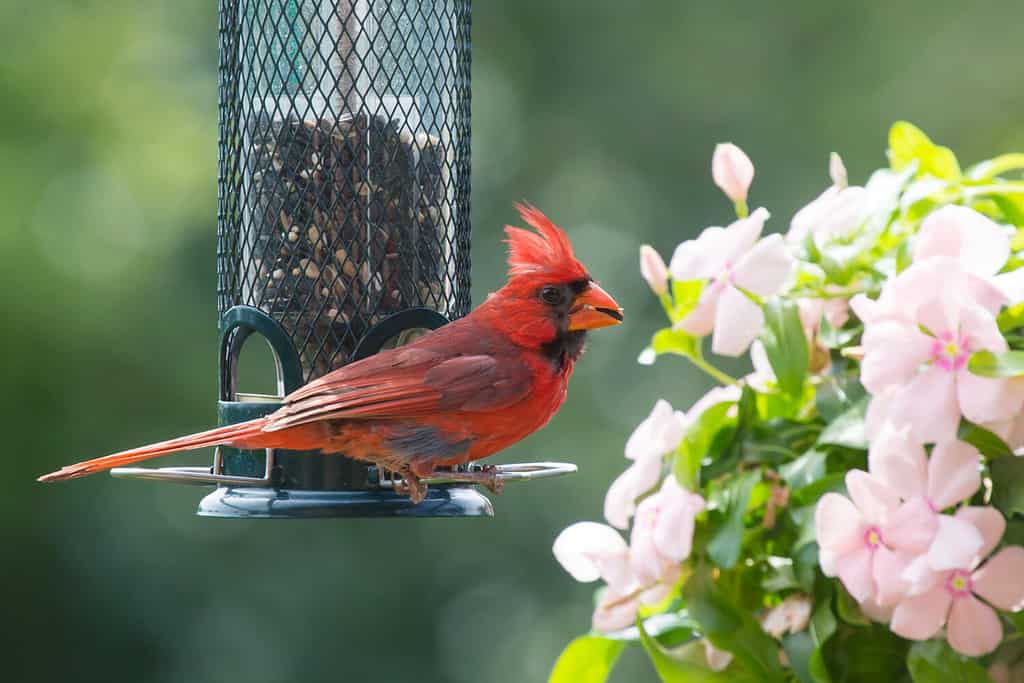
Birdfeeders are a fun way to attract wild birds, but don’t be surprised if snakes follow suit and show up in your yard, seeking a meal.
©Ami Parikh/Shutterstock.com
Whether or not snakes help the environment, one thing is for certain–there are a lot of folks who are not keen on the idea of snakes of any kind slithering around on their property! We’ve put together a list of some steps you can take to make sure that you are not guilty of unknowingly inviting snakes onto your premises:
- Lawn upkeep–Stay on top of mowing your lawn and keep shrubbery trimmed, as snakes can be attracted to tall, overgrown grass and brush.
- Rid your yard of potential reptile shelters–any places where snakes can find shelter are attractive to them because they like to hide. Places they could hide would be leaf piles, wood piles, in empty containers like buckets or flower pots, or around large rocks. Checking for and removing these hiding places can discourage snakes.
- Eliminate food sources for snakes–Snakes like to prey on rodents and birds, as well as other small mammals. If you have birdfeeders to attract wild birds, you could also be inviting snakes into the yard. Make sure to actively curtail rodents on your premises as well, as they also attract snakes.
- Rid your yard of any standing water–Standing water is a definite draw to snakes, whether it be ponds, bird baths, fountains, or puddles.
- Have outdoor pets that scare away snakes–Dogs and cats are often enemies of snakes, as well as some kinds of chickens, so these are potential options for keeping snakes away.
Discover the "Monster" Snake 5X Bigger than an Anaconda
Every day A-Z Animals sends out some of the most incredible facts in the world from our free newsletter. Want to discover the 10 most beautiful snakes in the world, a "snake island" where you're never more than 3 feet from danger, or a "monster" snake 5X larger than an anaconda? Then sign up right now and you'll start receiving our daily newsletter absolutely free.
Thank you for reading! Have some feedback for us? Contact the AZ Animals editorial team.

